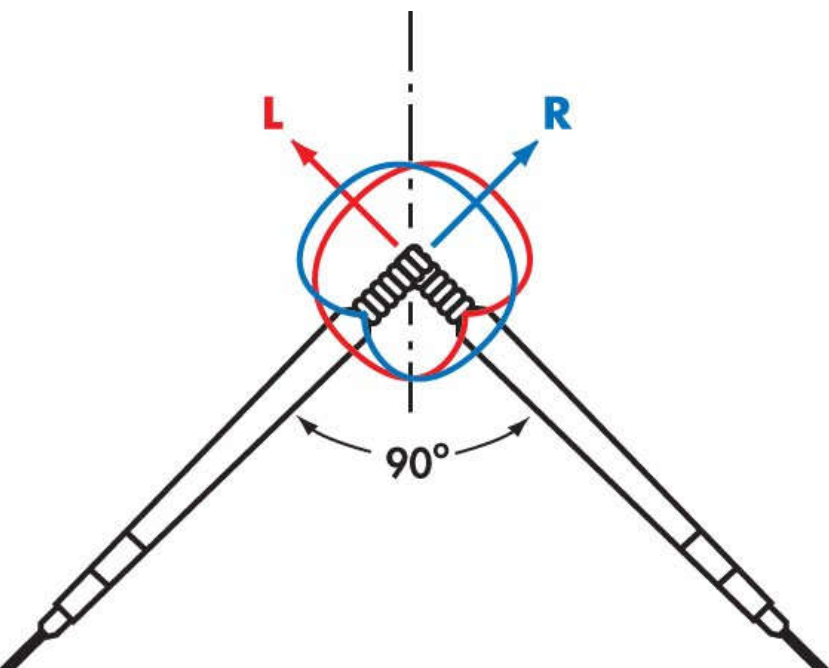News
Stereo recording technique is usually done with 2 or more microphones. Here are Sonar Studio's collection of 5 stereo recording techniques to share to technicians as well as all professional recording enthusiasts to better understand Stereo recording
X-Y techniques
X-Y technique is very easy to implement and produces relatively good sound, good mono compatibility. You just need to make sure of the following requirements:
2 identical microphones (same model, same manufacturer), same polar pattern (usually cardioid)
Set diagonally from 90 to 135 degrees depending on the size of the source (orchestra or drums kit, piano ...) or aesthetics. The most common setting is 90 degrees. This mic angle is very common in commercially available stereo microphones (for example, Audio Technica AT2022).
2 mic heads placed as close as possible. Maximum distance is 12 inches (~ 30.5 cm). The most common and safest setting is that the two microphone heads almost touch each other as shown.
Stereo-Miking-X-Y-Technique (1)
X-Y Stereo Recording Technique
When finished recording, you can pan 2 arbitrary signals to get the sound, width as you like. X-Y's Mono compatibility can vary from pretty good to excellent depending on the distance between the two mic capsule heads.
Mid-Side Stereo Technology (M-S)
Similar to X-Y, this is an easy setup technique. In my personal experience, the stereo sound when using the M / S technique is very natural, the space is wider than XY and the mono compatibility is good. Many solo classical music albums (especially guitar) have been recorded by this method. I also had the opportunity to experiment a few times when recording classical guitars and enjoyed the results.
Stereo-Miking-Mid-Side-Technique
Mid-Side Stereo Recording Technique
The technical requirements of the Mid-Side are a bit more complicated than that of XY. You will need 2 microphones with different audio characteristics.
Mic A: 01 mic cardioid or omni towards the source, capture sound directly. Often people use Cardioid but in the album "El Diablo Suelto" by John Williams, sound engineer uses Omni mic. I also tried both options and enjoyed the latter option.
Mic B: 01 mic Figure-8 (bi-directional mic) toward 2 left, right of Mic A to catch sound indirectly. Mic B is located just below or on Mic A.
The signal obtained from Mic A can pan into the center (Center). The signal received from Mic B is duplicated (or copied) into a second signal channel. The two signal channels formed by Mic B are left, right and one side inverted.
If you want to reduce the width of the picture, lower the signal strength of the 2 Mic B channels. If you want to increase the width? Do the opposite. Very simple, right.
Sounds obtained using absolute mono-compatible M-S technology! The reason is simple. Because 1 of 2 signal channels of Mic B is the polar opposite of the other channel, so when mono, these 2 channels cancel each other out. As a result, you will hear sound only from Mic A without encountering any consequence of comb-filtering.
Blumlein technique
Similar to X-Y, the Blumlein technique is easy to set up, gives very natural sound, good mono compatibility and is very popular when recording pianos, drums room, ambience.

Thu-am-stereo-Blumlein
Stereo Blumlein Recording Technology
Setting up Blumlein:
Use the same 02 microphone (same model, same manufacturer) with polar pattern Figure-8 (bi-directional mic)
Set 2 mic to make a 90 degree angle, 2 mic capsules as close as possible
Signal obtained from 2 mic can pan left and right with arbitrary width for good sound, best fit.
Technical Spaced Pair (A / B)
This technique is very popular because of its flexibility and wide sound, but it is not very friendly for beginner stereo receivers because of combfiltering problems and mono compatibility is not as high as XY, MS. .
Stereo-Spaced-Pair
Stereo Spaced Pair Recording Technology
To set up the Spaced Pair, we need:
02 microphones with the same model and polar pattern (cardioid or omni)
02 mic this is set from 90 - 300 cm apart. Signal obtained pan left and right. The width of the pan can be arbitrarily determined by the sound engineer
Spaced Pair technique is often applied when recording orchestra (symphony, chorus ...) or large instruments such as drums, piano ... Depending on the actual size of the source, you can change the distance between 2 mic to match.
As mentioned above, Spaced Pair is more prone to phase issues than previous techniques. The main reason is that the distance between the 2 mic is larger, so the time from source to 2 mic may have a larger difference. For example, when we record drums overheads, drummers hit HiHat, the mic near HiHat (mic A) will pick up the sound before the other (mic B). However, when the drummer struck the Ride card, the nearby mic (mic B) picked up the signal in front of the mic near HiHat (mic A). When combining the signal to mono, such differences in time will make the phase interaction of the two signal sources become more complex, it is difficult to create a stable and consistent result when playing drummer.
Therefore, it is a habit to listen to the stereo recording on mono continuously to ensure the setting position of your notes.














